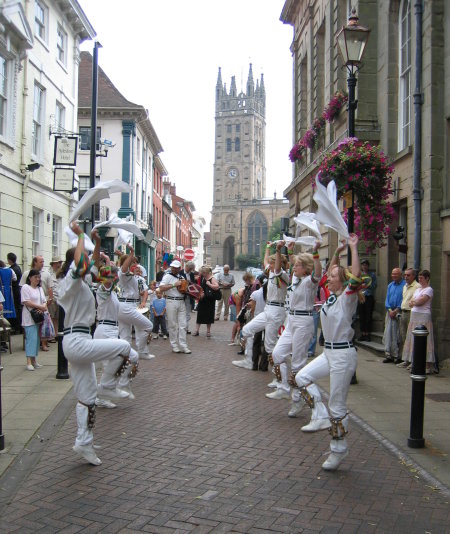 Photo: Wikipedia.
Photo: Wikipedia.
 Photo: Wikipedia.
Photo: Wikipedia.
You’ve seen the bells, the sticks, the handkerchiefs—and maybe you’re wondering what on earth is going on. Whether you’re curious, sceptical, or thinking of joining in, Cotswold Morris dancing has something to say to you.
What you saw was Cotswold Morris dancing, a traditional English folk dance that’s been around for centuries. It comes from the villages of the Cotswold Hills, a region in south-central England, and is usually performed by six dancers in white, with bells on their legs and either handkerchiefs or sticks in hand.

The dancers form patterns whilst performing quite complex steps: lines moving forward and back, weaving in and out, dancing in circles. We dance to live music from a melodeon (that’s a button accordian / squeezebox) and drum, creating a rhythmic, joyful spectacle.
Cotswold Morris is a living tradition, passed down through generations. Although each particular village tradition had its own steps, tunes, and style, each new generation, each new team, each new dancer has their own interpretation. You can find more information about the specific styles we dance here.
A Day of Dance (which is perhaps what you saw) is more than just entertainment — it’s a cultural event. It brings together sides from across the region (and sometimes beyond) to share dances, music, and camaraderie. It’s colourful, musical, and deeply rooted in English folk heritage. It’s not just a performance; it’s a celebration of community, tradition, and fun.
We hear you. That’s a common stereotype—but it’s not the full picture.
Yes, Morris dancing has deep roots, and yes, some dancers have been doing it for decades. But today’s Cotswold Morris scene is diverse, dynamic, and evolving. You’ll find dancers of all ages, genders, and backgrounds. Some sides are traditional, others are experimental. Some perform in pubs, others at festivals or even abroad.
People dance Morris because it’s fun, it’s social, and it’s real. It’s not about being trendy—it’s about doing something joyful, physical, and connected to a shared cultural story.
Why do people care? Because it brings people together. Because it makes people smile. And because it’s a blast to do.
That’s brilliant! Cotswold Morris is welcoming, inclusive, and a lot of fun. You don’t need to be an expert dancer—just willing to learn. We offer taster sessions in the Autumn and will be happy to teach you some steps, some dances, and something about the traditions.
You’ll find that morris is:
If you enjoy music, movement, and a bit of tradition, you’ll fit right in.
Take action now! Have a chat with a dancer when we’re out and about, or contact us by phone or email, or message us on Facebook or Instagram.
If you don’t live near Windsor (more than an hour’s drive away, perhaps) and want to find a Morris team near you you can use the Morris Federation’s “Team Finder”.
No. You might hear of morris dancing being a survival of pagan fertility rites, but this is just a romantic myth. Some modern teams may call themselves ‘pagan’ however — perhaps because they genuinely adopt a symbolic, nature-revering, and ritualistic approach to their dance, or perhaps because it’s a great excuse to dress up!
The earliest evidence of morris dancing dates from the 15th century, when royal courts and wealthy households throughout Europe were paying for ‘Morys’, ‘Morisk’, ‘Moresca’ or similarly named dancers – these were highly-paid professionals providing high-status entertainment.
In 1600, Shakespearean actor Will Kemp danced a Morris Dance from London to Norwich in nine days, to raise money and as a publicity stunt. We know this because he wrote a booklet about it, which he called Nine Daies Wonder.
But what was called “Morris” from this time doesn’t really look like what you might see today…
However, we do know that Morris dances of the sort you see today were being performed in the nineteenth century (i.e. the 1800s).
We know this because the dances (and music) were written down in the late 19th and early 20th centuries by collectors who had the time, money and interest enough to travel througout England asking old people about the music and dance of their youth (which would be the mid-1800s). What these people described is by and large the basis of what is danced today, though, of course, many of today’s dances are modern evolutions.
Why did these collectors do this? Well, towards the end of the 19th and the start of the 20th centuries, there was a big upsurge in interest in national folk customs, including folk music. But what was this “music from their own lands”? They had to go out and find it. We are grateful to these collectors, as without them it is highly unlikely that we would know much about these dance traditions at all - they were dying out and might have disappeared without trace (as we know many, many Cotswold village traditions did).
Yes. The term Morris Dancing covers a number of forms including dances with clogs, bells, hankies, sticks, swords and disguised faces. What links all these styles today is that the dances are done for show. It brings people together; it makes people smile; and it’s a blast to do!
If you want to find out about other types of Morris, check out this page from the Morris Federation or go to their YouTube channel and browse.